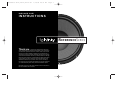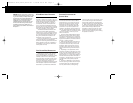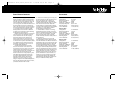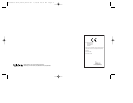
WARNING: Playing loud music in an automotive
environment can permanently damage your hear-
ing, as well as hinder your ability to hear traffic.
The maximum volume levels achievable with
Infinity speakers, combined with high power
amplification, may exceed safe levels for
extended listening. We recommend using low
volume levels when driving. Infinity accepts
no liability for hearing loss, bodily injury, or
property damage as a result of use or misuse of
this product.
A FEW WORDS ABOUT ENCLOSURES
Your Reference Series subwoofer
requires an enclosure to realize its full low-
frequency response. The speaker’s design is
flexible enough to produce exceptional
results no matter whether you specify a
small sealed, vented or bandpass enclo-
sure. In vented and bandpass enclosures,
box size and port tuning frequency will also
help dictate the low-frequency performance
and output capability of your system.
Your Reference Series subwoofer will
also work in infinite baffle applications
where there is no space or budget to build
a box. Be aware that infinite baffle or “free
air” mounting will reduce the power han-
dling of any subwoofer compared to an
application using an enclosure.
Finally, any deviation from recommended
enclosure volumes or port dimensions
should be made using dedicated enclosure-
design software. If this type of software is
not available to you, ask your authorized
Infinity dealer for help.
YOUR CAR AND BASS REPRODUCTION
Depending on the size of the vehicle’s
interior listening space, reproduced fre-
quencies below 80Hz are boosted by nearly
12dB per octave in the car as frequency
decreases. NOTE: This effect, known as the
vehicle’s transfer function, plays an impor-
tant part in shaping the overall in-car
response and is displayed graphically along
with freespace response on the enclosed
data sheet for your Reference Subwoofer.
ENCLOSURE CALCULATIONS AND
BUILDING BOXES
Use the recommended box designs on
the enclosed data sheet. Choose cabinet
dimensions to fit your vehicle, but do not
change the enclosure’s volume. Doing so
will change the tuning frequency of the
enclosure and may adversely affect final
performance. If you cannot perform the
necessary calculations yourself, please con-
tact your authorized Infinity dealer for help.
In addition, there are a number of points
you’ll want to keep in mind as you con-
struct an enclosure:
1. Use 3/4" (19mm) MDF (medium-density
fiberboard) or marine birch wood to build
an enclosure. Enclosures for 12" and larger
subwoofers, or small subwoofers driven by
high-power amplifiers, should be construct-
ed using 1" (25mm) material.
2. Seal all joints with glue and screws; do
not use nails. We recommend "deck", "zip"
or drywall screws since they have coarse
threads for better grip and don’t require
pre-drilling holes. Once the box has been
tested, seal all interior joints with silicone
caulk.
3. Depending on the application, fill the
enclosure according to the design you have
chosen from the enclosed data sheet in one
of three ways: zero-percent fill (i.e., no fill),
50-percent fill (i.e., 1"-thick polyfill sheets on
all inside walls except where subwoofer is
mounted), or 100-percent fill (i.e., entire box
is stuffed with loosely packed polyester
fiberfill).
4. Use PVC or ABS pipe for ports. Keep in
mind the openings at either end of the port
must be at least one port diameter away
from any obstructions, including filling
material inside the box. Rectangular vents
can be used as long as the cross-section
surface area matches the recommended
port-area values in the enclosed data sheet.
5. When using vented boxes, we recom-
mend using a subsonic filter (like the DBO™
feature found on Kappa Series power
amplifiers) to limit the power sent to the
speaker at frequencies below, the enclo-
sure’s port tuning frequency, thus limiting
the speaker’s excursion.
Reference 811w,1011w,1211w OM 7/14/98 10:31 AM Page 2






